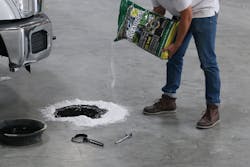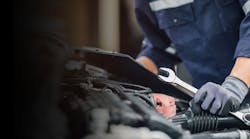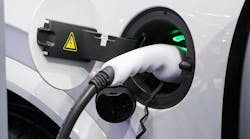Vehicle maintenance departments and repair shop floors can end up a huge mess due to spills or leaks of oil, grease, brake fluid, transmission fluid etc., creating a dangerous slip and fall hazard and interrupting work flow until it is cleaned up. Clay absorbents can leave a hard-to-remove residue that typically must be scrubbed with secondary cleaning methods, including a mop and bucket. This in turn leaves slippery wet spots to dry, followed by disposal of the oily water, which may be regulated.
“Absorbents like clay can become sticky when used to clean up spills or leaks on the shop floor,” says Anthony Eid, owner of Perris Auto Repair, a repair shop in Perris, California. “Mopping can make a mess if you push spilled oil and clay absorbents around. It is not effective and people can slip, fall and get hurt until any spill is fully cleaned up and the floor is dry.”
A new breed of commercial absorbents was designed to simplify spill cleanup safely and quickly so work can resume with no hazardous dust, slick residue or heavy lifting.
Dustless cleaning products
Commonly used cleaning absorbents such as clay or diatomaceous earth are extremely dusty in their natural form and can be hazardous when inhaled. While water can be added to reduce dust, as soon as the water evaporates (when a package is left open for instance), they return to their very dusty original state.
“Products like clay can dust up unless you wet them down, and they get dusty when they dry out,” says Eid. “We want to avoid any dangerous dust in our enclosed, indoor shop environment.”
Many absorbents, like clay and diatomaceous earth, contain crystalline silica, which is listed by the World Health Organization as a Group 1 carcinogen, the same category as asbestos. If inhaled, crystalline silica can also cause silicosis, a debilitating and sometimes fatal lung disease. OSHA recommends “replacing crystalline silica materials with safer substitutes, whenever possible.”
As a solution, a growing number of vehicle maintenance and repair shop managers are turning to safer “dustless” alternatives. One example, a cleaning absorbent called Eco-Absorb, which is made from an all-natural, non-toxic earth compound and certified by NSF International for its safety around humans and food, is permanently “dustless” without adding water. Because of this, it can be used safely without worry of inhalation, and will remain dust-free even when exposed to the open air indefinitely. Eco-Absorb can be used to clean up spills such as oil, coolant, transmission fluid or fuels.
No “Slippery” Residue
To protect shop mechanics and other workers from slip and fall accidents, which can be costly and carry some liability, managers also need to use a spill clean up product that does not leave water (like mopping) or an unsafe residue. Absorbents like clay and diatomaceous earth leave a residue that requires a secondary cleaning process, and can be slick and remain a hazard when wet. To address these concerns, innovations in spill management technology have eliminated the need to add water to some products, as well as handled the issue of leftover residue.
Because all natural absorbents like Eco-Absorb are applied dry, they reduce the risk of slip and fall liability. When placed around a spill, the absorbent acts like a sponge. It quickly absorbs the spill material and binds to it. This makes it easy to sweep up the substance, along with the absorbent, into a dustpan, to dispose of in a proper solid waste receptacle.
No Heavy Lifting
Another issue with spill cleanup absorbents like clay and diatomaceous earth is that they are extremely heavy. Because such products have relatively low absorption to weight ratios, a lot of product must be used to clean up spills of any size. As a result, a worker could easily injure himself or herself handling multiple 50 pound bags of clay or diatomaceous earth to clean up a spill. This is another potential worker’s compensation or liability risk.
The weight and quantity of absorbent is also an issue when it comes to disposing of it after the spill cleanup.To address such issues, innovative absorbents now pack more absorption power in a lower weight. This makes bags of product safer and easier to handle, as well as less costly for disposal since such fees are usually based on weight. Absorbents like Eco-Absorb weigh one-third less than traditional clay products but can absorb up to 15 times more, so less product is needed to do the job.
Neutralizing Acid Spills
While the vast majority of vehicle maintenance and repair shop spills are materials like lubricants, oil and grease, occasionally cleaning up battery acid or other caustic liquids is required and that can be an issue of worker safety. To ensure safety, some new products can actually indicate if a substance is hazardous by changing color. This is important to prevent accidental exposure and injury.
One innovative, absorbent, cleanup aid can neutralize a chemical hazard and indicate the substance’s pH level. It does so by turning red for dangerous acids and blue for dangerous bases. When the harmful substance is neutralized, it changes back to its original natural color, indicating that it is safe for disposal.
With better spill cleanup options being made available, shop managers can keep employees safer and the service center more productive. A cleaner shop will also help the shop to pass required inspections, as well as impress customers.


